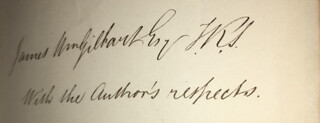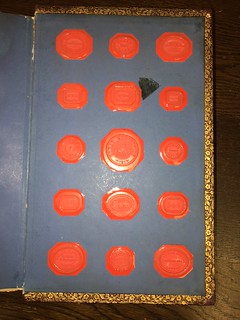
PREV ARTICLE
NEXT ARTICLE
FULL ISSUE
PREV FULL ISSUE
HI-TEC BANKING AND THE PREVENTION OF FORGERYDouglas Saville submitted these notes inspired by an article in our print journal The Asylum. Thanks! -Editor
I found David Gladfelter’s article in the Winter 2017 issue of The Asylum - The Nineteenth-Century Bookcase - interesting, and I was pleased to see that the 3rd edition of Ruding’s Annals of the Coinage of Great Britain (1840), and the first edition of Barclay Head’s Historia Numorum, 1887 were regarded as fundamental works by Elvira Clain-Stefanelli. In the author’s paragraph about Books on Banking, he mentions that one of the few published in the U. S. before 1900 was Lawrence Lewis Jr’s A History of the Bank of North America, 1882. He goes on to describe “an unusual book about bank operations”- it was the third edition of Granville Sharp’s The Gilbart Prize Essay on the adaptation of recent discoveries and inventions in science and art to the purposes of Practical Banking, and was published in London in 1854. It is a quite remarkable and fascinating volume - and I totally agree with David that it “remains a trove for the business historian”. A few years ago I was fortunate to purchase the inscribed copy from Granville Sharp to the donor of the original Prize, J. W. Gilbart. Here is my description of it……. HI-TEC BANKING AND THE PREVENTION OF FORGERY- THE AUTHOR’S PRESENTATION COPY TO JAMES GILBART. SHARP, Granville. The Gilbart Prize Essay on the adaptation of recent discoveries and inventions in science and art to the purposes of Practical Banking. ... Third English edition, with diagrams and illustrations. London, Groombridge and Sons, 1854.
 The best, and only illustrated, edition. Inexplicably, not noticed by Murray McKerchar [A papermoney bibliography, Spink, 1979]. Not in AMEX Collection Catalogue. Honeyman: 2844. It is extremely rare to find an absolutely complete copy, as, apparently, the present example, with most copies being short of the full complement of plates, and the few other examples we have seen have been severely defective. [A printed explanatory notice, on blue paper, was tipped-in onto the first free-endpaper of an example previously handled by us, and it read: “Many persons will probably be surprised at finding objects referred to in this work, which appear to have but little connexion with its immediate subject. An explanation may be afforded in the fact that these matters were very cursorily introduced into the original manuscript, with little expectation that it would ever re-appear. As this has however been thrice printed and publicity thereby given to these articles, it is thought that the Exhibitors may be entitled to any advantage which this further publication may afford; and the Author hopes that his readers will cheerfully pass over those parts which they may deem out of place. East of England Bank, Norwich, 10 th June, 1854”]
This third edition of Sharp's original paper is no less than a detailed, fully illustrated, report on mid-19th century hi-tec banking. It comprises the widest possible range of technical developments and inventions affecting everything from the fixtures and fittings for a bank, including its heating, lighting, and ventilation, the health of employees, materials required, including inks, paper, pens, and account books, scales, copying machines, printing and engraving, locks, cashboxes, safes, and much else. Improvements in security printing and engraving were the key, however, particularly when the combination of art and science helped to prevent bank note forgery. And so, the first 28 plates all provide samples of bank notes, watermarked security paper, bank cheques and similar material, several on coloured or tinted paper. They include a Perkins' bank note "with combination of difficult engraving", another "faced upon Perkins and Co's patent for the prevention of anastatic and photographic forgery", and several examples of other so-called forgery-proof notes and cheques. Collation is complicated, at the least, as there are numerous additional inserts. These are, apparently, required leaves, or plates, or examples not listed in the printed list of engravings, and copies seem sometimes to exist with fewer, and more often significantly fewer, inserts, possibly because supply from some of the manufacturers simply ran out. These examples are usually lettered (e.g. plate '13' comprises actually folding leaf '13', five leaves 13A, 13A2 + 13B, 13C, 13D, 13E, 13F, 13G, 13H, 13I, 13K, 13L, 13M, 13N and 13O). Counted thus, the 'total' number of plates, samples and promotional leaflets is about 170. The present example is of particular interest, having such a remarkable association, being the copy presented by Granville Sharp to James Gilbart, and is apparently totally complete. UNIQUE.  Wayne Homren, Editor The Numismatic Bibliomania Society is a non-profit organization promoting numismatic literature. See our web site at coinbooks.org. To submit items for publication in The E-Sylum, write to the Editor at this address: whomren@gmail.com To subscribe go to: https://my.binhost.com/lists/listinfo/esylum All Rights Reserved. NBS Home Page Contact the NBS webmaster 
|

